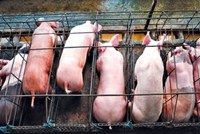Advertisement
Grab your lab coat. Let's get started
Welcome!
Welcome!
Create an account below to get 6 C&EN articles per month, receive newsletters and more - all free.
It seems this is your first time logging in online. Please enter the following information to continue.
As an ACS member you automatically get access to this site. All we need is few more details to create your reading experience.
Not you? Sign in with a different account.
Not you? Sign in with a different account.
ERROR 1
ERROR 1
ERROR 2
ERROR 2
ERROR 2
ERROR 2
ERROR 2
Password and Confirm password must match.
If you have an ACS member number, please enter it here so we can link this account to your membership. (optional)
ERROR 2
ACS values your privacy. By submitting your information, you are gaining access to C&EN and subscribing to our weekly newsletter. We use the information you provide to make your reading experience better, and we will never sell your data to third party members.
Environment
Food Irradiation
Recent E. coli outbreaks heighten interest in the technology
by Bette Hileman
January 15, 2007
| A version of this story appeared in
Volume 85, Issue 3

Food-borne infections cause about 76 million cases of illness, 325,000 hospitalizations, and as many as 5,000 deaths in the U.S. annually. In other words, they send one in 1,000 Americans to the hospital each year and kill thousands.

There is no single way to prevent all food-borne illness, but many food safety experts believe irradiation—subjecting the food to ionizing radiation—should be used much more widely as part of an overall program to enhance safety. Radiation for this purpose is provided by gamma rays from cobalt-60 or by electron beams from a linear accelerator. The radiation damages the DNA of disease-causing bacteria, such as Salmonella or Escherichia coli 0157:H7, as well as the DNA of insects, preventing reproduction.
Gamma rays and electron beams have identical effects on food. But gamma rays penetrate farther than electrons, so they can be used to irradiate bulk foods in shipping pallets.
About 50% of Americans hold negative opinions about food irradiation. They believe it is expensive and possibly dangerous and that it changes the flavor of the food. They also complain that it would lead to poor sanitary practices in the growing, harvesting, and processing of food.
In the U.S., irradiation is employed primarily on spices, chicken, and ground beef. The Food & Drug Administration has not yet approved it for pathogen control in fresh fruits and vegetables. In 1999, the Food Irradiation Coalition—a group of food processors, health organizations, and academic groups—submitted a petition to FDA to use irradiation on bagged fresh fruits and vegetables to help eliminate microbial pathogens, but the agency has not yet reached a decision.
Last year's outbreaks of E. coli 0157:H7 in fresh bagged spinach and in lettuce served at Taco Bell and Taco John's restaurants, however, have increased interest in the technology. In the spinach incident in August and September, 204 people were sickened, 102 were hospitalized, 31 developed kidney failure, and three eventually died from eating contaminated spinach. The immediate cause of the spinach incident was feral pigs that ate grubs in cow manure on a free-range pasture and then wandered into neighboring spinach fields, contaminating the spinach with their infested manure (C&EN, Dec. 11, 2006, page 28).
In the taco incident, as many as 150 people across the Northeast and upper Midwest became ill after eating at Taco Bell and Taco John's restaurants. At the height of the outbreak, about 90 restaurants across the Northeast and Midwest were closed. Many of the victims ended up in hospitals, and some are still relying on kidney dialysis to stay alive. After a long investigation, FDA decided that the cause was lettuce contaminated with the same microbe as was on the spinach—E. coli 0157:H7.
Ten years ago, the majority of food-related E. coli infections were caused by contaminated ground beef. But those incidents have declined 42% since 1996, when the Department of Agriculture established the Hazard Analysis Critical Control Points system for meat-processing plants. In recent years, E. coli 0157:H7 infections have been linked mostly to fresh produce, primarily from central California. In all, 20 documented incidents involving leafy vegetables have occurred in the past decade.
E. coli 0157:H7 is a particularly nasty microbe. It produces a poison called Shiga toxin, and microbe levels as low as 50 cells per gram of food can sicken a child, says Aubrey Mendonca, a food science researcher at Iowa State University. "With other organisms, such as Salmonella, you need a few thousand microbes per gram," he says. Furthermore, there are many sources of E. coli 0157:H7—cattle, deer, some wild birds, other wild animals. It doesn't cause disease in animals, and the contamination in any particular field can be spotty, he explains, making it difficult to detect.
Those who advocate the use of irradiation to kill E. coli say it should be used as a last step in a careful protocol for growing, harvesting, and processing vegetables. William Marler, a leading Seattle-based attorney who represents victims of E. coli poisoning, wants Congress and FDA to consider whether irradiation of "all mass-produced foods, including produce, is an option."
To be successful, however, irradiation of fresh produce must be done very carefully, says Lane Highbarger, consumer safety officer at FDA's Center for Food Safety & Applied Nutrition. Because produce has a high water content, it tends to react poorly to intense radiation, he says. If the dose is too high, it changes the taste, texture, or odor of the food, he explains.
"Some studies have been done on shredded leafy green vegetables to see what levels of radiation would be potentially effective at controlling microbiological contamination while keeping the quality of the food acceptable," he observes. "Leafy green vegetables irradiated at levels up to 1 kiloGray [kGy] have been shown to be indistinguishable from normal unexposed leafy green vegetables."
For example, Xuetong Fan, research technologist at USDA's Agricultural Research Service, has found that most fresh-cut fruits and vegetables can tolerate 0.5 to 1.0 kGy radiation without significant deterioration in product quality. "However, 1 kGy often has only a moderate effect on controlling microbiological contamination," Highbarger says.
But there are exceptions. Several researchers at Chapman, Iowa State, and Texas A&M Universities have come up with promising results with electron-beam irradiation. For example, Denise M. Foley, assistant professor of biology at Chapman, found that E. coli levels could be reduced by a factor greater than 100,000—a 99.999% reduction—if lettuce is first washed in a chlorine solution and then irradiated with a dose somewhat lower than 1 kGy.
Alejandro Castillo, associate professor in the department of animal science at Texas A&M, inoculated spinach with three strains of E. coli 0157:H7 and reduced the contamination to an undetectable level (below 10 cells per g of food) with an energy dose of 1.2 kGy. The appearance of the spinach leaves was unchanged by the irradiation and the shelf life may have been improved, he says. Irradiation may be a viable alternative for decontamination of spinach, he explains, "but it should not substitute for good agricultural practices and sanitary processing."
Jaejoon Han, a Texas A&M researcher, packed romaine lettuce in plastic bags coated with a natural antimicrobial agent and then subjected them to electron beam irradiation. The bags were coated with a plant-derived trans-cinnamaldehyde (trans-3-phenyl-2-propenal), which FDA considers safe for food use. He found that irradiation treatment combined with the antimicrobial packaging reduced the microbes 25% more than irradiation alone.
"We should irradiate all fresh produce to eliminate microbial problems before they reach the consumer," says Elena Castell-Perez, associate professor of biological and agricultural engineering at Texas A&M. "We are working on it here, trying to develop the right treatments so we don't reduce the quality of the produce," she notes. "Washing by itself won't take care of the problems because E. coli sometimes gets inside the cells of the produce.
"Our researchers are getting data showing what doses would be appropriate for E. coli or Listeria in bagged leafy greens and mangoes," Castell-Perez explains. "We are working between 1 and 3 kGy. Maybe 1.5 kGy will do the job, but we need to look at whether it affects the quality of the produce. If we coat the plastic bags with an antimicrobial compound, maybe we can use only 1 kGy." The aim is to reduce the level of microbes by a factor of 100,000, she says.
Castell-Perez believes that if produce is irradiated, no less care will be taken to see that it is grown and processed under sanitary conditions. She estimates irradiation would cost 5 to 10 cents per lb if done on a large scale.
However, Tony Corbo, a lobbyist at Food & Water Watch, does not favor irradiation, even if it turns out to be inexpensive and the quality of the fruits and vegetables is preserved. He views irradiation as a Band-Aid when what is needed is a total overhaul of the food production system.
"There is a growing amount of pollution that is impacting the entire food supply, and somebody is going to have to come to grips with this," Corbo says.
Dairy operations should not be situated near produce fields, and run-off from livestock should not be allowed in produce fields, he continues. "We should not resort to invasive technologies like irradiation to make up for the fact that we are producing food in a degraded environment."
Robert V. Tauxe, a medical officer at the Centers for Disease Control & Prevention, says that current U.S. attitudes toward irradiation are very much like American's views of milk pasteurization in the 1930s before it became common practice. At that time, he explains, many people said pasteurization would be too expensive, reduce the vitamin content of the milk, and lead to unsanitary practices on dairy farms because pasteurization would be used as a final step to kill microbes. But in fact, widespread pasteurization adds little to the cost of milk and has eliminated many illnesses caused by pathogens in dairy products.
More research to establish effective radiation doses that do not harm product quality is probably necessary before FDA will act on the petition to irradiate bagged fresh vegetables and fruits. If it does eventually approve the petition, the agency will face strong opposition from many environmental and consumer groups who are fiercely opposed to the technology. Even though irradiating food with gamma rays or electron beams creates no radioactive components, the public-interest and consumer groups that advocate the creation of a single food safety agency and stronger regulations to protect food tend to oppose both nuclear power and food irradiation.
It would take many more tragic food-poisoning incidents and extensive public education before coalitions would emerge that would favor both stronger rules and laws to promote food safety and exposing foods to gamma rays or electron beams. Congress would have trouble taking any action on irradiation so long as public opinion remains extremely polarized.
Read More
- Food Irradiation
- Recent E. coli outbreaks heighten interest in the technology
- Mixed Picture
- Irradiation Has Benefits But May Hurt Flavor





Join the conversation
Contact the reporter
Submit a Letter to the Editor for publication
Engage with us on Twitter